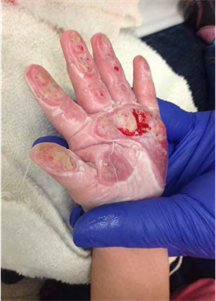Glass-Fronted Gas Fireplace Burns: An Under-Recognized Winter Risk to Children

Michael A. Gittelman, MD, FAAP
February 4, 2019
The warm glow and dancing flames of a fireplace on a chilly winter day can be irresistible--especially to a curious toddler. That proved to be the case for a 3-year-old patient, who was recently rushed to our emergency department by his mother.
The boy’s hand was badly burned after touching the glass door of the family’s gas fireplace. His mother explained that she was making dinner when she heard him scream.
“I didn’t know the glass would get that hot,” she said. Through tears, she asked if her child would have permanent damage to his hand.
Cases like this are far too common. More than 120,000 U.S. children receive care in emergency departments for fire or burn-related injuries each year. Children under 5 years old are disproportionately affected. Scald injuries, from boiling liquids or contact with hot objects, tend to be the most common type of thermal injury to young children, accounting for over 65 percent of the cases.
Young children, like the boy in my emergency room, are at particular risk for burns from glass-fronted gas fireplaces. This type of fireplace is popular with families since they are easier to use, less expensive, and easier to clean than their wood burning counterparts. They have become a common feature in more newly constructed homes.
The problem is that gas fireplaces lack the characteristic smoky smell and crackling sound of an intensely hot flame, and they can reach temperatures as high as 1328 degress Fahrenheit. In addition, their glass front can remain hot for even an hour after the fire has been turned off.
Initially, burns from gas fireplaces were under-reported in the literature, so the extent of the problem was not clear. I was fortunate to work with Dr. Lucy Wibbenmeyer and colleagues to conduct a 5-year retrospective study of glass-fronted gas fireplace burns. Our research, which was published in the Journal of Burn Care and Research, helped reveal how commonly children suffer from these types of burns.

From the 17 burn centers participating in the study, 402 injuries were reported. This translated into an estimated 17,000 annual medical visits, 360 emergency room visits, and 33 admissions annually. Hand injuries on the palmer surface to toddlers, as in the case of the child I treated, accounted for over 95 percent of these injuries. Up to 11 percent of them were severe enough to require surgery.
"Gas fireplaces lack the characteristic smoky smell and crackling sound of an intensely hot flame, and they can reach temperatures as high as 1328 degrees Fahrenheit. In addition, their glass front can remain hot for even an hour after the fire has been turned off.”
Education and safety measures are urgently needed to help prevent children from being burned by glass-fronted gas fireplaces. Fortunately, new standards were approved by the Consumer Product Safety Commission that require all new gas burning fireplaces to be sold with a safety barrier and information about burn risks. Families that already have a gas fireplace in their home, especially those with toddlers, should purchase a barrier or fireplace covering, separately, in order to block curious toddlers from getting near the hot glass surface.
Even with these barriers in place, families with toddlers need to know they should provide close supervision when the fireplace flame is active or recently turned off. Considerable attention should be given to active toddlers visiting another family’s home with a gas fireplace or at resorts that may have a gas fireplace with no barrier. Another prevention action could be to consider barriers like gates to keep children out of rooms with a fireplace entirely, or simply not using a gas fireplace when you have toddlers in the house. If the fire is providing ambiance but is not essential for heating a home, it may not be worth the risk until the child is older.
Wintertime can be so much fun for families: seeing young children discover the joy of playing in freshly fallen snow, for example, or sipping their first cup of warm cocoa. Let’s help educate families about the risk of glass-fronted gas fireplaces in the home. These injuries can be serious, and they are 100% preventable!
*The views expressed in this article are those of the author, and not necessarily those of the American Academy of Pediatrics.
About the Author
Michael Gittelman, MD, FAAP
Michael Gittelman, MD, FAAP, is a member of the American Academy of Pediatrics Council on Injury, Violence and Poison Prevention and President of the Ohio Chapter. Dr. Gittelman is also a Professor of Clinical Pediatrics in the Division of Emergency Medicine and Co-Director of the Comprehensive Children’s Injury Center at Cincinnati Children’s Hospital.